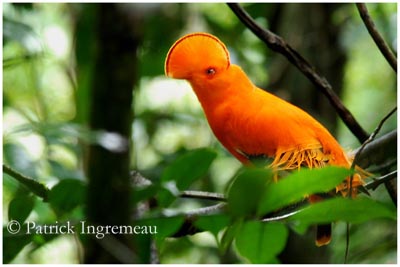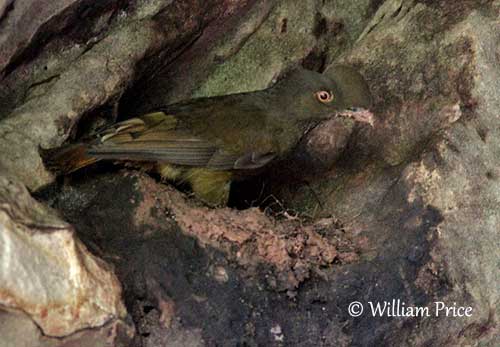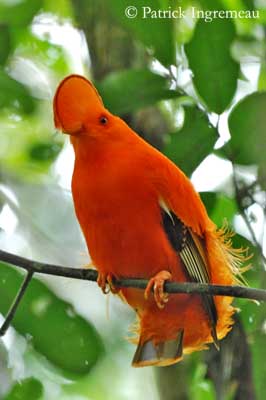
Guianan Cock-of-the-rock
Rupicola rupicola
Passeriforme Order – Cotingidae Family
BIOMETRICS:
Length : 27-32 cm
Weight : M : 200-218 g – F : 203 g
LONGEVITY: Up to 7 years
DESCRIPTION:
The Guianan Cock-of-the rock is a wonderful bird with stunning orange plumage and conspicuous rounded crest.
Fr: Coq de roche orange
All: Tiefland-Felsenhahn
Esp: Gallito de las Rocas Guayanés
Ital: Galletto di roccia della Guiana
Nd: Oranje Rotshaan
Russe: Оранжевый скалистый петушок
Port: Galo-da-serra
Marc Chrétien
MURINUS
Patrick Ingremeau
TAMANDUA
William Price
PBase-tereksandpiper & Flickr William Price
Text by Nicole Bouglouan
Sources :
HANDBOOK OF THE BIRDS OF THE WORLD Vol 9 - by Josep del Hoyo - Andrew Elliot - David Christie - Lynx Edicions - ISBN: 8487334695
A GUIDE TO THE BIRDS OF COLOMBIA by Steven L. Hilty and William L. Brown - Princeton University Press – ISBN 069108372X
L’ENCYCLOPEDIE MONDIALE DES OISEAUX - Dr Christopher M. Perrins - BORDAS - ISBN: 2040185607
PORTRAITS D’OISEAUX GUYANAIS - Groupe d'étude et de protection des oiseaux en Guyane (GEPOG) - Ibis rouge éditions - ISBN: 2844501842
Wikipedia (Wikipedia, The Free Encyclopedia)

Adult male has bright orange body plumage.
The wings are black with pale orange to creamy-white edges. The primaries show large whitish speculum. The broad secondaries show long fringes (or filaments) on inner feathers. The tail is blackish with pale orange to buff tips.
We can see almost similar pattern on back and uppertail coverts.
Head is bright orange too, with conspicuous crest. There are two rows of feathers, flattened against each other, forming perfect semicircle. This crest has fine brown subterminal band. It is always erected and covers the base of the bill.
The bill is powerful, slightly hooked at tip, yellow with orange base.
Eyes are orange. Legs and feet are yellowish-orange.
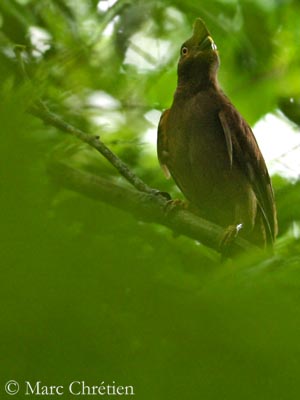
Female is quite different. She has blackish-brown plumage, greyer on the head. Secondary feathers are slightly bleached. Belly is buffier. Rump shows ochraceous-brown tinge.
On the head, the crest is smaller than in male. Eyes are paler, dull orange. Bill is blackish with yellow tip. Legs and feet are dark brownish.
Immature female resembles adult female.
Immature male is also similar to adult female, but at one year, it shows orange speckles. At two years, the plumage is mainly orange slightly blotched brown. At three years, the young male acquires the full adult plumage.
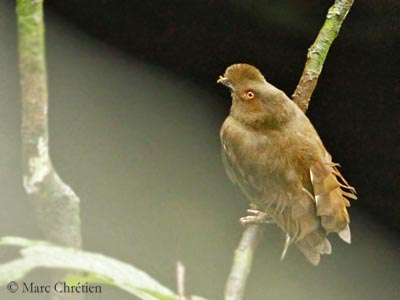
MALE
IMMATURE
VOICE: SOUNDS BY XENO-CANTO
Guianan Cock-of-the-rock males utter different loud, raucous notes at lek, in confused chorus.
During the displays, while flying towards the lek, they give raucous “karhaoouw”, but also series of unpleasant noises against the other males, such as bill snapping above the lek.
The wings produce a low whistle during the flight.
We can hear a loud “waa-oww” when the birds are foraging.
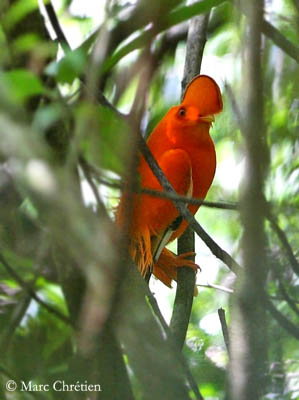
HABITAT:
Guianan Cock-of-the-rock lives in low tropical humid forests, near the rocky areas providing good nest-sites.
Female frequents high screes, cliffs and caves.
RANGE:
Guianan Cock-of-the-rock is found in Guyana, E. Colombia, S. Venezuela, Suriname, French Guiana and northern Amazonian Brazil.
BEHAVIOUR:
Guianan Cock-of-the-rock feeds mainly on fruits, but it also takes large insects, small reptiles and frogs. The bird takes the fruit while flying. It may consume numerous kinds of fruits according to the season and the location.
This species seems to be sedentary in its range, and only performs short-distance movements, probably related to fruit availability.
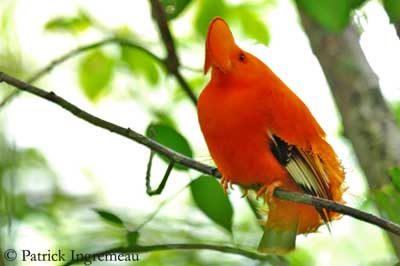
The Guianan Cock-of-the-rock is known for its wonderful displays at the beginning of the breeding season.
Several males (between 5 and 25, but sometimes up to 40-50) gather at communal leks, where each male has its own territory of about one or two metres of diameter. They usually display on the ground, but they spend much time in the lower branches of the nearby trees, above the lek. Each male defends its territory and the closest perches. During this period, we can often hear very noisy aggressive displays between them.
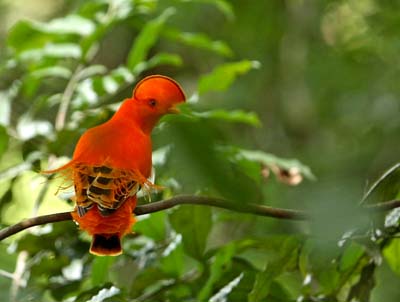
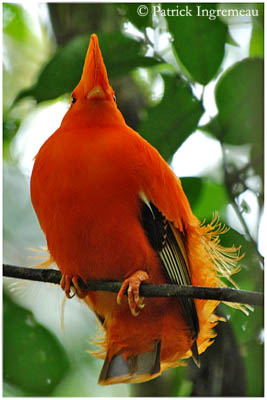
When one or several females arrive in the trees above the lek, each male goes to its small territory and crouches, motionless and silent. The plumage is fluffed, mainly wing coverts and rectrices, in order to display the bright orange colour of their plumage, surrounded by the silky filaments which move on rump and wings.
At this moment, females move down to lower branches and look at the males.
One female may fly down to a male’s territory, and land behind the male. She sometimes pecks the filaments of his plumage. Then, the male hops around her and eventually mounts.
Males are polygamous and do not take part to the nesting duties after mating.
FLIGHT:
Guianan Cock-of-the-rock performs strong and direct flight. If threatened, it is able to fly away very easily, thanks to the short but powerful wings.
REPRODUCTION:
Guianan Cock-of-the-rock female builds the nest alone. This nest is often placed under rocky overhang, in crevice or at cave’s entrance. Sometimes, several nests (up to six) may be built relatively close to each other.
Nest is a large cup made with grass and mud, sheltered from bad weather and water. The cup is plastered to vertical rocky wall and the bird uses the saliva as cement. The nest is situated in semi-darkness.
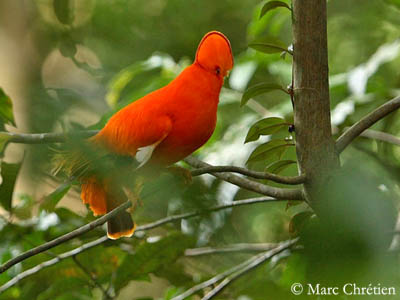
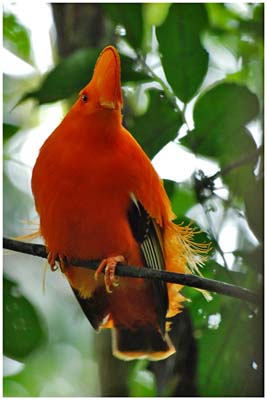
DIET:
Guianan Cock-of-the-rock feeds mainly on varied kinds of fruits from numerous plants’ species. They also consume small reptiles (snakes and lizards), frogs and large insects. Fruits are taken from the vegetation while flying.
PROTECTION / THREATS / STATUS:
Guianan Cock-of-the-rock is fairly common within the range.
This species needs rocky areas for nesting, and this fact can reduce the range. But this bird is present in protected areas in several countries of the range, and this species is not threatened at this moment.
Guianan Cock-of-the-rock is one of the most famous species of Neotropical birds, symbols of South American avifauna.
